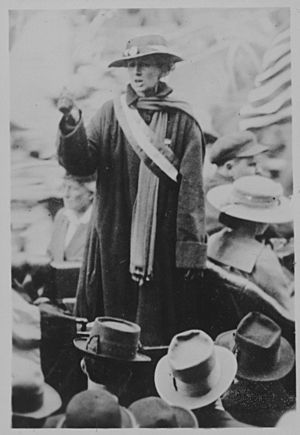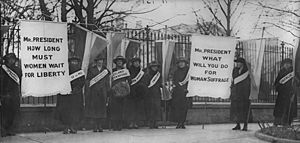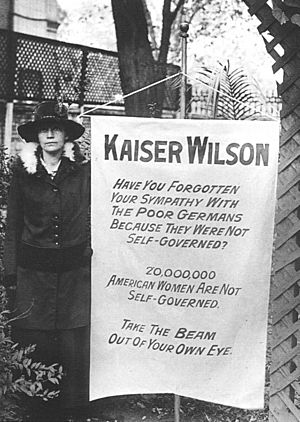Silent Sentinels facts for kids
The Silent Sentinels were a group of brave women who fought for women's right to vote, also known as suffrage. They were organized by Alice Paul and the National Woman's Party. These women stood silently in front of the White House during Woodrow Wilson's presidency. Their protest began on January 10, 1917. They were the first group ever to picket the White House.
The Silent Sentinels started their protest after a meeting with President Wilson. He had told them to "concert public opinion on behalf of women's suffrage." The women became a constant reminder to Wilson that he was not fully supporting women's voting rights. At first, their protests were allowed. But later, they were arrested for blocking traffic. The women continued their silent protest until June 4, 1919. That's when the Nineteenth Amendment to the United States Constitution, which gave women the right to vote, was passed by both the House of Representatives and the Senate.
The name Silent Sentinels came from their quiet way of protesting. Harriot Stanton Blatch first used this name. Using silence was a new and powerful way to protest within the women's suffrage movement.
During their two-and-a-half-year protest, nearly 2,000 women took part. Many were treated unfairly by local and U.S. authorities. They faced harsh treatment, especially during the "Night of Terror" on November 14, 1917. Almost 500 women were arrested, and 168 of them spent time in jail.
Contents
The National Woman's Party
The Silent Sentinels' protests were organized by the National Woman's Party (NWP). This group was dedicated to getting women the right to vote. The NWP was first started as the Congressional Union for Woman Suffrage (CUWS) in 1913. It was founded by Alice Paul and Lucy Burns. They had also helped organize a big women's suffrage parade in Washington D.C. in March 1913.
The CUWS took a more direct approach to women's suffrage. It was different from the more moderate National American Woman Suffrage Association (NAWSA). The CUWS later joined with the Woman's Party to form the National Woman's Party. The NWP had fewer members than NAWSA (50,000 compared to a million). However, their methods, like picketing the White House and going on hunger strikes in jail, got a lot more attention from the media.
The Suffragist Newspaper
The Suffragist was the weekly newspaper of the National Woman's Party. It was like the voice of the Silent Sentinels during their protests. The newspaper reported on the Sentinels' activities. It also included interviews with the protesters and updates on President Woodrow Wilson's reactions. Political essays were also a part of the paper.
When the Sentinels were in prison, some members wrote about their experiences. These stories were then published in The Suffragist. The newspaper was meant for many people to read. However, most copies went to party members and organizers. This shows that the suffragists themselves were a main audience for the publication.
Protest Banners and Colors
The Silent Sentinels used banners to share their messages. These banners often had powerful questions or quotes.
Here are some examples of what their banners said:
- "Mr. President, how long must women wait for liberty?"
- "Mr. President, what will you do for woman suffrage?"
- "We shall fight for the things which we have always carried nearest our hearts—for democracy, for the right of those who submit to authority to have a voice in their own governments."
- "The time come to conquer or submit, for us there can be but one choice. We have made it." (This was another quote from President Wilson.)
- "Kaiser Wilson, have you forgotten your sympathy with the poor Germans because they were not self-governed? 20,000,000 American women are not self-governed. Take the beam out of your own eye." (This banner compared Wilson to Kaiser Wilhelm II of Germany. It also used a famous quote from Jesus about hypocrisy.)
- "Mr. President, you say liberty is the fundamental demand of the human spirit."
- "Mr. President, you say we are interested in the United States, politically speaking, in nothing but human liberty."
The Sentinels wore sashes that were purple, white, and gold. These were the official colors of the NWP. Their banners were also usually made with these colors.
Public Reactions to the Protests
People had many different reactions to the Silent Sentinels.
Some people strongly supported the Sentinels. Men and women near the White House would show their support. They brought the women hot drinks and warm bricks to stand on. Sometimes, women would even help hold the banners. People also wrote letters praising the Sentinels to The Suffragist. Many also donated money to help their cause.
However, others did not approve of the Silent Sentinels' protests. This included some of the more moderate suffragists. For example, Carrie Chapman Catt, who led the National American Woman Suffrage Association, believed in a different approach. She thought it was better to get the right to vote state by state first. Then, women could vote for politicians who supported suffrage in Congress. Until late 1915, she was against pushing for a national amendment. Members of the National American Woman Suffrage Association worried that the pickets might make male voters angry.
People who were against women's suffrage also opposed the Silent Sentinels. Sometimes, crowds tried to stop the Sentinels with violence. This became worse after the U.S. entered World War I. For instance, some people attacked the Sentinels and ripped their banners. This often happened with banners that were more challenging, like those calling Woodrow Wilson "Kaiser Wilson."
At first, President Wilson did not react much to the women's protest. Sometimes, he even seemed amused, tipping his hat and smiling. It was said that he once invited them in for coffee, but the women politely refused. At other times, he completely ignored the protests. This happened when the Sentinels protested on the day of his second inauguration ceremony. As the Sentinels continued their protest, the issue became more important. Wilson's opinion began to change. Even though he still disliked the Silent Sentinels, he started to see them as a serious group raising an important issue.
Occoquan Workhouse and the "Night of Terror"

On June 22, 1917, police arrested protesters Lucy Burns and Katherine Morey. They were arrested for blocking traffic. They had a banner quoting President Wilson's speech. On June 25, 12 more women were arrested for the same reason. They included Mabel Vernon and Annie Arniel. They were told to pay a $10 fine or spend three days in jail. They chose jail. They wanted to show how committed they were to their cause.
On July 14, 16 women were arrested. This group included Matilda Hall Gardner, Florence Bayard Hilles, Alison Turnbull Hopkins, and Elizabeth Selden Rogers. They were sentenced to 60 days in jail or a $25 fine. Again, the women chose jail. Lucy Burns argued that they should be treated as political prisoners. However, this idea had never been used in America before.
When too many women were arrested for the District of Columbia Jail, they were sent to Virginia's Occoquan Workhouse. Once there, they had to give up all their belongings except their clothes. They were then told to bathe. There was only one bar of soap for everyone in the workhouse. Because of this, all the suffragists refused to use it. After bathing, they were given baggy, dirty, and uncomfortable prison clothes. The dinner they received was so bad they could barely eat it.
The conditions in both the District Jail and the Occoquan Workhouse were very unsanitary. Prisoners had to share cells and many other items. Worms were often found in their food.
In September 1917, the House of Representatives created a committee to discuss women's suffrage. This happened after a lot of debate. On September 14, Representative Jeannette Rankin visited the activists in the Workhouse. The next day, the committee sent the suffrage amendment bill to the Senate.
As the suffragists continued to protest, their jail sentences became longer. On October 20, 1917, Alice Paul was arrested. She was carrying a banner that quoted Wilson: "The time has come to conquer or submit, for us there can be but one choice. We have made it." She was sentenced to seven months in prison. Paul and some others went to the District Jail. Many more were sent back to the Occoquan Workhouse. Alice Paul was put in solitary confinement for two weeks. She only had bread and water. She became so weak she could not walk. She was then taken to the prison hospital. There, she started a hunger strike, and other women joined her.
To deal with the hunger strike, prison doctors force-fed the women. They put tubes down their throats. They gave them high-protein liquids, like raw eggs mixed with milk. Many women vomited because their stomachs could not handle the food. One doctor said Alice Paul had "a spirit like Joan of Arc." He added that it was "useless to try to change it. She will die but she will never give up."
On November 10, many Sentinels protested the force-feeding. About 31 of them were arrested and sent to Occoquan Workhouse. On the night of November 14, 1917, known as the "Night of Terror," the superintendent of the Occoquan Workhouse, W.H. Whittaker, ordered the guards to treat the suffragists harshly. They beat Lucy Burns and chained her hands above her head to cell bars. They left her there all night. They threw Dora Lewis into a dark cell and hit her head against an iron bed, which made her pass out. Her cellmate, Alice Cosu, thought Lewis was dead and had a heart attack. Dorothy Day was repeatedly slammed over the back of an iron bench. Guards grabbed, dragged, beat, choked, pinched, and kicked other women.
Newspapers reported on how the protesters were being treated. These stories made some Americans angry. They also created more support for the suffrage amendment. On November 27 and 28, all the protesters were released. This included Alice Paul, who had spent five weeks in prison. Later, in March 1918, a court ruled that the convictions of six suffragists were not valid. The court found that the reasons for their arrests were too unclear.
The Fight Continues and Victory
On January 9, 1918, President Wilson finally announced his support for the women's suffrage amendment. The next day, the House of Representatives passed the amendment, but only by a small number of votes. The Senate refused to even discuss it until October. When the Senate voted in October, it failed by two votes. Even after the court ruling, arrests of White House protesters started again on August 6, 1918.
To keep the pressure on, protesters began burning Wilson's words in "watch fires" in front of the White House on December 16, 1918. On February 9, 1919, they even burned an image of Wilson in effigy at the White House.
The National Woman's Party, led by Alice Paul, also urged citizens to vote against senators who opposed suffrage in the fall of 1918 elections. After the 1918 election, most members of Congress supported women's right to vote. On May 21, 1919, the House of Representatives passed the amendment. Two weeks later, on June 4, the Senate finally followed. With their work in Congress done, the protesters then focused on getting the states to approve the amendment.
The 19th Amendment was officially approved on August 26, 1920. Tennessee was the thirty-sixth state to approve it, which made it law. The Tennessee legislature approved the amendment by just one vote. A legislator named Harry T. Burn had been against the amendment. But he changed his mind after his mother sent him a telegram that said, "Dear Son, Hurrah! and vote for suffrage. Don't forget to be a good boy and help Mrs. Catt put the 'rat' in ratification."
Additional Resources
Websites
- Becoming a Detective: Historical Case File #3—Silent Sentinels
See also
 In Spanish: Centinelas Silenciosas para niños
In Spanish: Centinelas Silenciosas para niños



